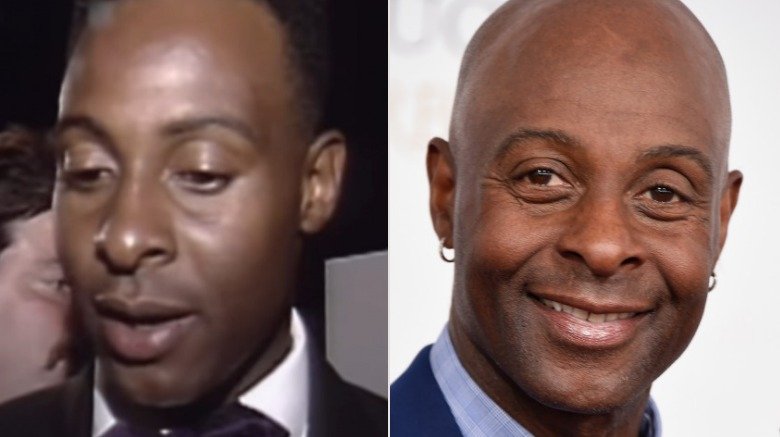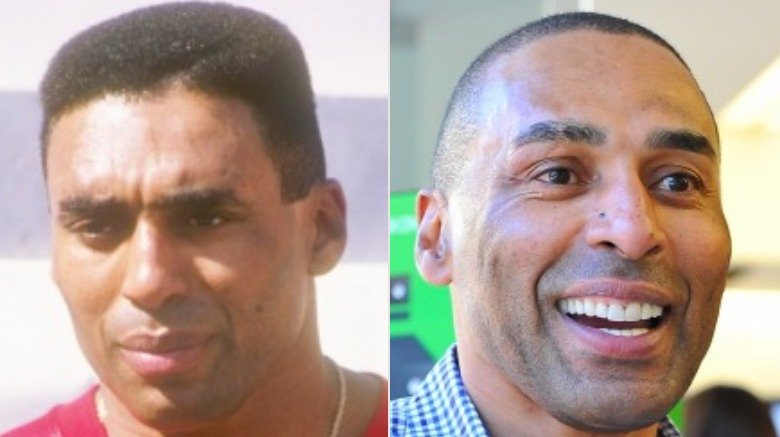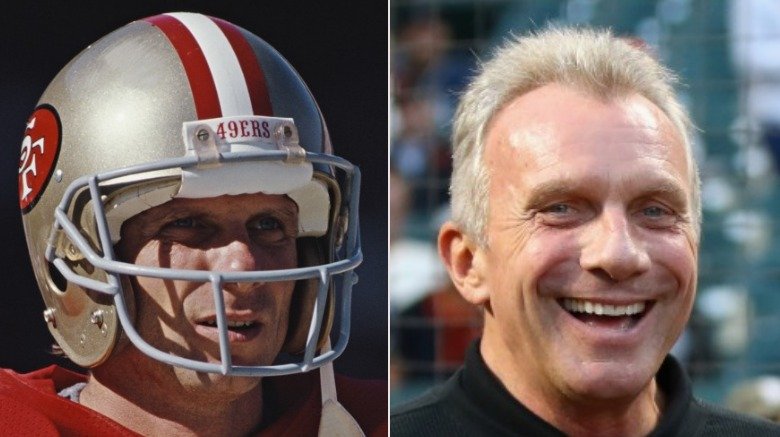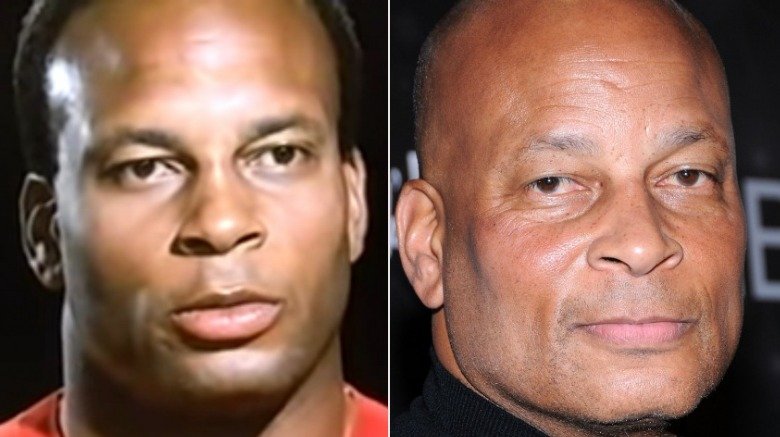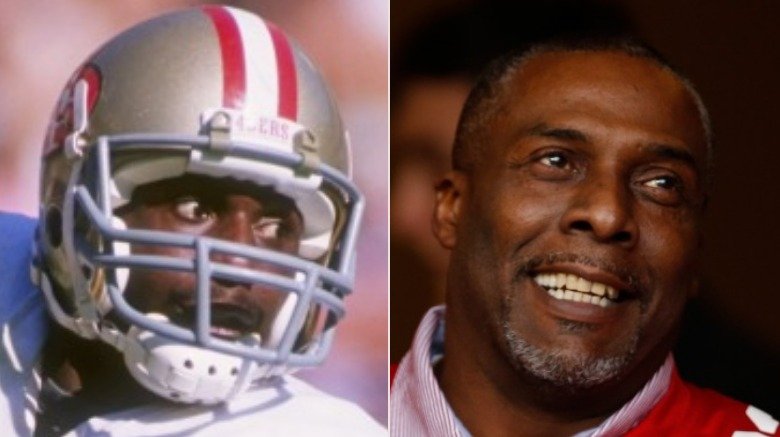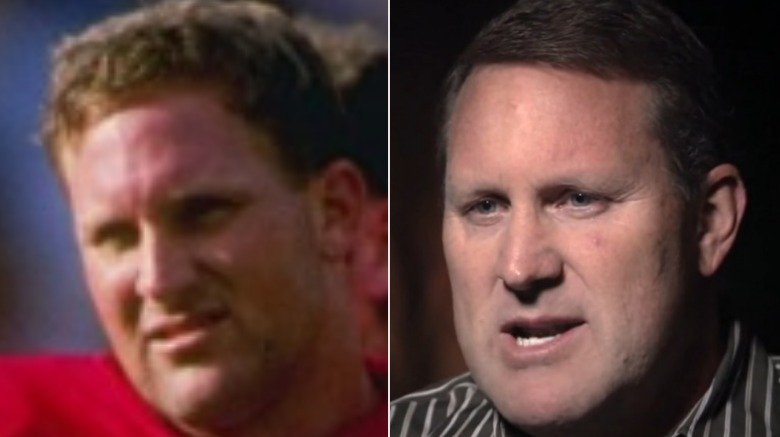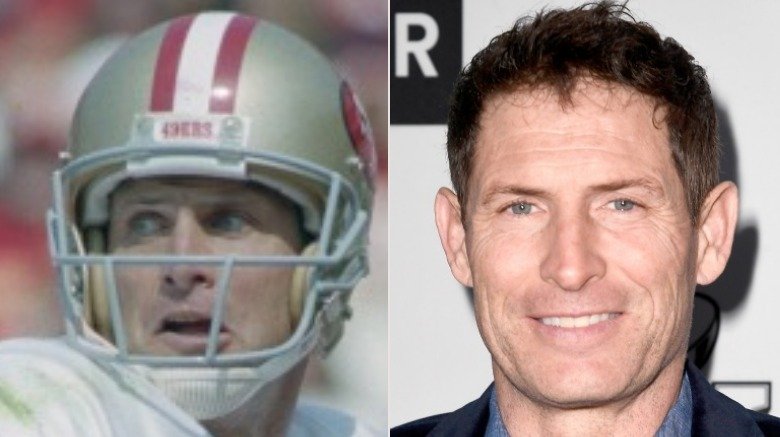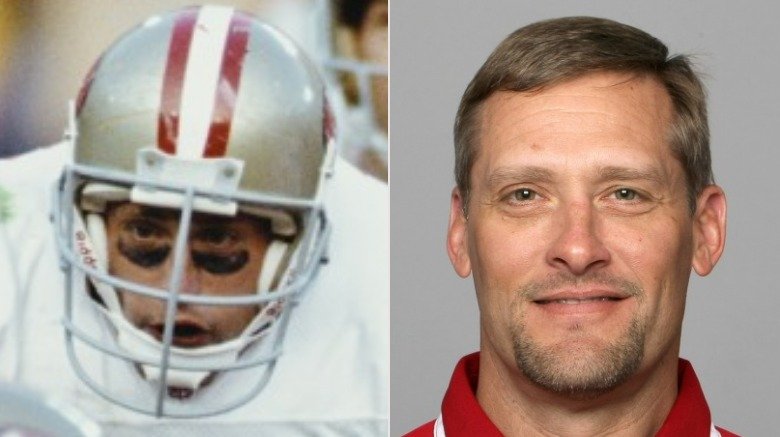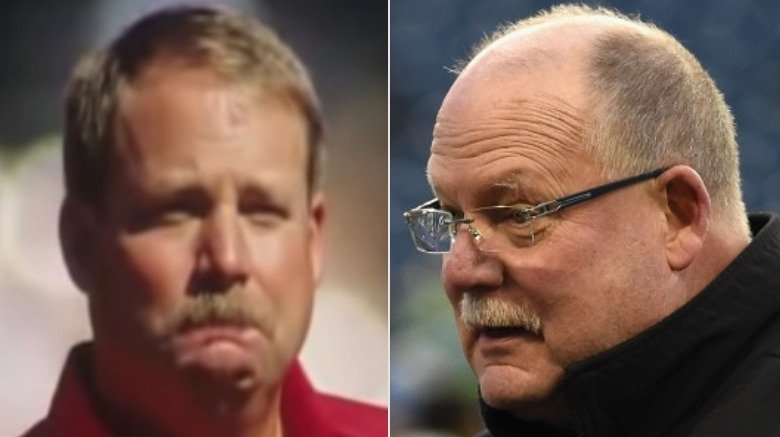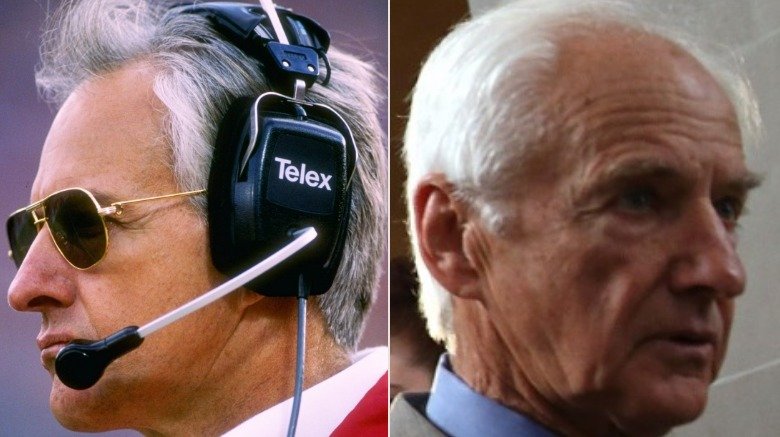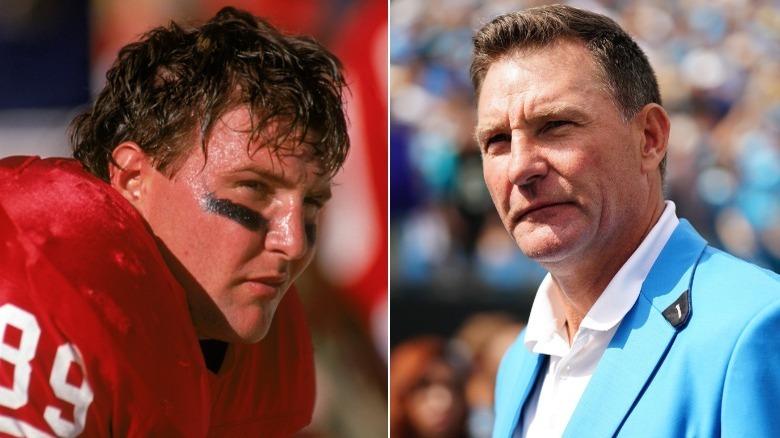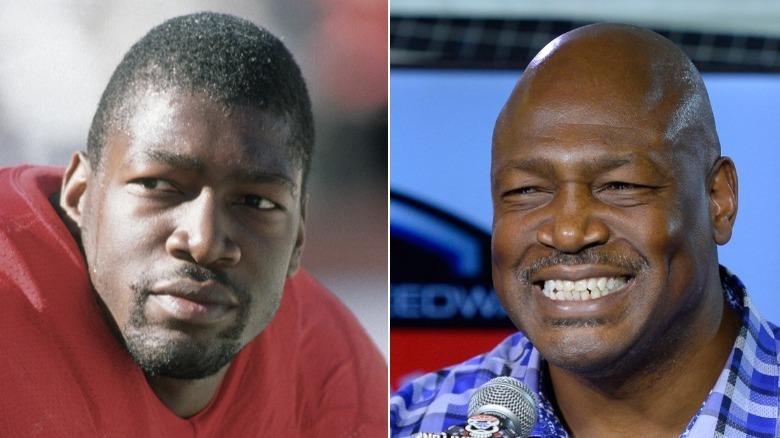What The 1989 San Francisco 49ers Look Like Now
There are offensive powerhouses, and then there are the San Francisco 49ers teams of the 1980s, which were more like offensive Death Stars. The fates of other teams throughout the NFL were sealed in 1979, when new head coach Bill Walsh used his first ever draft pick to secure Notre Dame quarterback Joe Montana. The man who would go on to become perhaps the greatest pure passer ever led the Niners to their first Super Bowl win in 1981, but that was only the beginning. The team would repeat three times throughout the decade, and at the height of its offensive powers in 1989, their season concluded with a complete destruction of John Elway and the Denver Broncos in Super Bowl XXIV by the ridiculous score of 55-10.
How good was the '89 squad? Montana averaged 9.1 yards per pass attempt during the regular season, as per ESPN, and when backup Steve Young took over for three games, he managed an eye-watering 10.9 yards per attempt. In the postseason, the 49ers outscored their opponents by a hundred points. Nobody could slow them down, let alone stop them, and they've consistently ranked among the greatest Super Bowl teams of all time. Plus, they did it all in their first season without the legendary Walsh. Here's what the stars of that insane juggernaut of a team are up to today.
Jerry Rice
With the 16th overall pick in the 1985 draft, the 49ers selected an undersized, not-particularly-speedy wide receiver from a tiny school. To say that Jerry Rice exceeded expectations would be a wild understatement. His addition to an already stacked offense that had just notched its second Super Bowl win elevated the 49ers from perennial contender to schoolyard bully; Rice made up for whatever shortcomings he had by being one of the most precise route runners in history and having hands made of Krazy Glue. By the '89 season, opposing defenses were well aware of his ability, but it mattered little. According to Pro Football Reference, Rice caught 83 passes for 1,483 yards that year, an 18.1 yard average, with 17 touchdowns; trying to account for him with double-teams and crazy defensive schemes only seemed to make him pile up more yards. He's widely considered to be the greatest receiver of all time, but many players would disagree — they'll tell you he was simply the best player, period.
As per ESPN, Rice always said that he never took time off from training in the offseason, nor has he in retirement. He says he's in better shape now — "more muscular" — than in his playing days, and says he still feels like he could play today despite the fact that he's in his mid-50s. Aside from fanatically working out, he's taken up another interesting hobby: crashing strangers' weddings. Like ... often. "It's so exciting to see their reaction," he says. Okay, so Rice is a little weird. He's earned that right.
Speaking of weddings, as reported by People, Rice married his longtime girlfriend Latisha Pelayo in 2019 — a year before his son, Brenden Rice, began his college football career. Look out, NFL, another serving of Rice is coming up.
Roger Craig
If you want to be a complete running back in the NFL today, you must have the ability to catch the ball coming out of the backfield — and for that, you can thank Roger Craig. It simply wasn't an expectation before Craig made it one; in 1985, he became the first player to post over 1,000 yards rushing and receiving in a season, and he finished his career with 4,911 receiving yards to go with his 8,189 yard rushing total. He was pretty much the first all-purpose back, which makes it puzzling that he's been overlooked for the Hall of Fame for a quarter of a century.
But, as with everything else, Craig takes the prolonged snub in stride. Literally: In addition to becoming a successful executive for a software company and fathering five children, Craig has spent his retirement continuing to run, reports the Quad-City Times. He's completed 38 marathons or half-marathons, weighs about as much as he did in high school, and like Rice is perhaps even more of a physical specimen today than he was during his playing years. He may not be the first name to pop to mind when thinking of those great 49er teams of the '80s, and it's starting to look like he may never get to Canton — but, he has his fistful of Super Bowl rings and the fact that he just totally kills it at life to ease that pain.
Joe Montana
The impact of Joe Montana on his position is impossible to overstate. His very name sounds like something a Hollywood screenwriter would dream up for a larger-than-life fairytale about the Ultimate Quarterback. He wasn't the biggest guy, nor did he have the strongest arm. He just saw the field more clearly than anyone else who had yet played the game and delivered passes right where they needed to be with unrealistic accuracy. For evidence, look no further than his game-winning TD pass in the 1981 NFC Championship against the Cowboys. Under intense pressure from Dallas defenders, Montana somehow put the ball where only receiver Dwight Clark — who was wearing a defensive back like a snug jacket at the time — could grab it, a play that immediately and forever after became known simply as "The Catch."
Such heroics would define Montana's career, but his retirement has been defined by pain, and lots of it. A USA Today reports, he's had three surgeries on his neck, has nerve damage in an eye and a left knee that's made out of spaghetti, and says that — due to more of that lovely nerve damage — he basically hasn't been able to feel his left foot since 1986. Of course, he's also become a successful and savvy investor with his own venture capital firm, as per Fox Business, so he has plenty of cash to deal with all those medical bills. "Unfortunately," he says with characteristic understatement, "most of us leave this game with things that linger."
Longtime fans and new converts alike can get more insight into Montana's stupidly legendary career if they happen to subscribe to Peacock. As reported by The Hollywood Reporter, the streamer produced a six-part docuseries, "Joe Montana: Cool Under Pressure," in 2022.
Ronnie Lott
Most great football teams have at least one big hitter on defense, but the 49ers had a Lott. Ronnie Lott, a ferocious free safety who was known to skew opposing player's yardage stats for the day by smacking them right into next week. Lott was a player who forced running backs and receivers to keep their heads on a swivel, lest he remove them from their bodies. The Hall of Famer is widely considered to be one of the best to ever play his position, and even with today's tighter rules, he's of the opinion that he still would have made just as big an impression in the modern NFL. In a 2015 interview (via Newsday), he said, "I still believe you can give fans that moment where they stand up and go, 'Oooh.' There's nothing that's ever going to stop that."
Lott has kept himself busy in retirement as an NFL and college football analyst and as a managing partner (along with former teammates Joe Montana and Harris Barton) of a capital investment firm, as per the Silicon Valley Business Journal. But strangely, although he's still a strong Niners booster, he's made news recently for his tireless (and unsuccessful) lobbying to keep the Bay Area rival Raiders in Oakland. He was part of an investment group that presented a $1.3 billion plan to build the Raiders a new stadium; Raiders ownership, characteristically, broke fans' hearts by rejecting the proposal.
John Taylor
Fans of pop music in the '80s may have been confused as to why one of the most awesome bassists of all time, Duran Duran's John Taylor, was suiting up for the 49ers, but football fans knew John Taylor as the dependable No. 2 receiver behind Jerry Rice. The season before the Niners' dismantling of the Broncos in the big game, Taylor had caught the winning touchdown in a Super Bowl showdown with the Cincinnati Bengals, cementing his status as a beloved player for the team with which he spent his entire nine-season career. A 115-pound weakling in high school, his first attempt at joining a college team as a walk-on failed; he then caught on at tiny Delaware State, where he set a couple of Mid-Eastern Atlantic Conference records, good enough for a third-round selection by the Niners in the 1986 draft. He quickly established himself as a viable deep threat alongside Rice, and a pretty solid punt return man as well.
He was also known for celebrating scores by performing backflips, something he's still fond of. In a 2018 podcast conversation with Matt Maiocco, he said, "As long as I can do the backflip, I know I'm OK. When I stop being able to do the backflip, then I got a problem." Not that he needs that skill very much in his current career: he owns his own big-rig trucking company, and although he's had as many as five employees, he loves to get behind the wheel himself.
Perhaps one day, the 49ers faithful will see Taylor roll right on into the Pro Football Hall of Fame. As reported by The Sporting News, he earned his first nomination in 2018 but unfortunately failed to make the cut.
Brent Jones
Tight end Brent Jones might have had a brilliant career with the Pittsburgh Steelers, the team that drafted him, if not for a bit of bad luck in the form of a serious car crash he was involved in right after the draft (via Niner Noise). With nerve damage in his neck, he was cut by the Steelers and picked up by San Francisco, where he took a few years developing into one of the most reliable players of his time at the tight end position. He made the Pro Bowl four times and racked up three Super Bowl rings on the way to a Hall of Fame-caliber career; unfortunately, the Hall isn't super-fond of tight ends. Only eight of them have been inducted ever, and Jones isn't holding his breath for the trend to magically reverse itself.
After his retirement in 1997, Jones went back to school and got a degree in economics, then co-founded his own venture capital firm in 2000. He also established a charity golf tournament to benefit underprivileged young people in Silicon Valley, in accordance with the Christian faith he says has guided him throughout his life. Pretty awesome guy, that Brent Jones — if Hall of Fame voters ever get over their allergy to tight ends, he may even one day get the recognition he deserves.
Steve Young
Speaking of men of faith, quarterback Steve Young — a backup on the '89 team who would go on to win the big one as a starter in '94 — has never been shy about his Mormon faith, even if he wasn't too charitable to opponents on the field. He executed plays with surgical precision in relief of Joe Montana for three games during the '89 run, and easily could have started for any number of teams before finally getting his shot. Strangely, he admitted after his playing days were long over to a lifelong struggle with severe anxiety, even though he appeared to have ice in his veins every time he stepped on the field. "I had to carry this horrific, in my mind, weight of being highly paid and the expectations that come with that," he told CBS Sports. "It just felt too much."
Young obviously overcame those struggles, and in addition to carving out a stellar post-retirement broadcasting career, he's used his platform to attempt to educate people on a number of important issues. He's been an outspoken proponent of using technology to mitigate the effects of concussions and brain injuries, and has gone against the position of his church by becoming a staunch advocate for LGBT rights — all the more impressive for the fact that he is a direct descendant of Brigham Young, the religion's founder.
Tom Rathman
The position has practically disappeared from the NFL these days, but in the '80s, the fullback was the guy tasked with opening up holes for the rushing game. For the 49ers and Roger Craig, that guy was Tom Rathman, and boy, did he do his job. Craig's punishing lead blocker was just as tough to stop with the ball in his hands as without; in the Niners' Super Bowl demolition of Denver, he chipped in with 81 total yards (rushing and receiving) and a pair of touchdowns (via Pro Football Reference). It helped that Rathman was a guy who got up in the morning and ate football for breakfast, gorged on football for dinner every night, and slept on a bed of football.
He didn't give up these habits after his playing days were done. He spent 14 seasons as running backs coach for the Niners, a position he has also held with the Detroit Lions and Oakland Raiders, but wasn't retained when Kyle Shanahan took over as San Francisco's head coach in 2017. After taking a year off, Rathman landed a job with the Indianapolis Colts, coaching running backs for their newly minted head coach, Frank Reich. He says he wasn't sure whether another position would materialize after being away from the game for a year, but is grateful that an old adage proved itself true. "They say that good things happen to those who wait," he told the Sacramento Bee. "I waited."
After a long and fruitful career both on the field and the sideline, the Rath (nobody calls him that, we just thought it sounded cool) retired in 2021, an occasion that prompted the Colts to celebrate his "31 years of excellence" on Twitter.
Mike Holmgren
Mike Holmgren is today remembered largely as the rotund, severe-looking guy who led Brett Favre and the Green Bay Packers to Super Bowl glory as that squad's head coach in 1995, but it was in San Francisco that he acquired the offensive coaching skills to pay the bills, so to speak. He served as the Niners' quarterbacks coach from 1986 to 1988, as per the NFL, then moved to offensive coordinator for three seasons before jumping ship to Green Bay in 1992. Said Joe Montana of Holmgren, "There are certain things he demanded you to study. He was a perfectionist at the position. That's what made a difference in him is he wanted it to be perfect and he wanted you to be perfect," which explains a lot about Montana's superhuman level of play.
Holmgren would go on to coach the Seattle Seahawks for a decade, becoming one of very few coaches in NFL history to take two different teams to the big game by leading the Hawks to Super Bowl XL in 2005. (They lost to the Steelers.) He also briefly spent time in the thankless position of Cleveland Browns president and has dabbled in broadcasting. But his offensive-minded legacy lives on: Coaches who have found success after learning from him include Steve Mariucci, Jon Gruden, and Andy Reid.
George Seifert
In 1989, George Seifert had the unenviable task of taking over the 49ers from Bill Walsh, one of the most respected coaches in history and practically a saint among Niners fans. He responded by immediately posting the most lopsided win in Super Bowl history, then picking up another ring in '94 on his way to becoming the winningest coach in San Francisco's history, as per Niners Nation. At various times, his coaching staff included Mike Shanahan (who would guide the Broncos to a pair of Super Bowl wins) and Pete Carroll (who would later give the Seahawks their only championship), and his legacy doubtless would have left a stronger impression had he not followed Walsh.
Seifert took over head coaching duties for the Carolina Panthers for three seasons after leaving the 49ers, but only managed a record of 16-32, leading to his dismissal following the 2001 season. He's been retired and out of the limelight since, and he just has one regret. In a 2013 Charlotte Observer interview, Seifert said, "The only regret is we didn't get it done [in Carolina]. I wish we had won more games." The coach followed that up by noting that his final 1-15 season for Carolina had a bit a silver lining for the team: "I gave them an opportunity to get a pretty good pass rusher [Julius Peppers], who helped them get to the Super Bowl. Out of something bad came something good, right?"
Wesley Walls
49ers fans remember tight end Wesley Walls, if they remember him at all for catching one lonely reception for nine yards (as documented by Pro Football Reference) in San Francisco's mega-thrashing of the Broncos in the Super Bowl following the '89 season. It was the dubious highlight of an uneventful rookie season for Walls, and his next two seasons with the Niners — during which he added only 11 more catches — were just as quiet. After a shoulder injury sidelined him for the entirety of the 1993 season, Walls signed with the Saints, not as a pass catcher but, according to the Carolina Panthers' official website, as a long snapper. Slowly, he began to get healthy and catch a few balls, and in 1995, he bolted to the expansion Panthers — where, in his words, "all this good stuff happened to me."
That good stuff: a whole heaping pile of receptions, yards, and TDs over seven seasons with the Panthers. Also: five Pro Bowls, a 1999 season during which he tied an NFL record for touchdowns by a tight end with twelve, and a spot in Carolina's Hall of Honor. With him, in only their second season of existence, the Panthers went 8-0 to start, won their division, and made it all the way to the NFC Championship, where they lost to the eventual champion Packers. "That was a breakout year for me," Walls said. "We sent a message to the league that we were for real. And when I got here, this city felt like home to me." It certainly must have — Walls still lives in Charlotte to this day, and presumably bleeds blue and silver.
Charles Haley
Linebacker Charles Haley was, simply put, one of the most terrifying men to ever step onto a football field. He was drafted by the Niners in 1986, and according to Pro Football Reference, he registered a ridiculous 12 sacks that season despite only starting one game. He was selected to the first of five Pro Bowls two seasons following, and in 1989 he victimized opposing defenses to the tune of 10.5 sacks and three fumbles (recovering one) on the way to helping shut down the high-scoring Broncos in the big game. He was big, fast, hard-hitting, and mean. "You never knew when he was going to go off," 49ers running back Dexter Carter told the Baltimore Sun (via CBS Sports). "Other guys would kid around and tease, but Charles was different. He was meaner. I didn't like the guy, and I told him that to his face. And believe me, I'm not alone."
As it turned out, there was a reason for that. As reported by Sportscasting, Haley struggled with undiagnosed bipolar disorder, which just might have contributed to his issues with anger and aggression. While these issues didn't prevent him from becoming the first player to win five Super Bowls (two with the 49ers and three with the Cowboys), they certainly didn't help him become endeared to his teammates, and he endured a reputation as a hothead for the entirety of his career. Fortunately, he didn't remain undiagnosed — and post-football, he opened up about his struggles and became a strong advocate for mental health. Of course, this hasn't kept him being outspoken: As recently as 2022, as reported by Inside the Star, the Hall of Famer blasted the Cowboys and coach Mike McCarthy for their soft play after their wild card loss to (who else) the 49ers.

